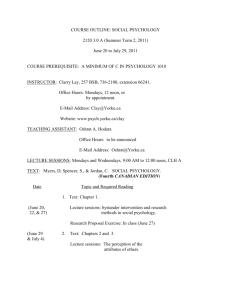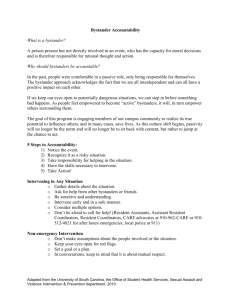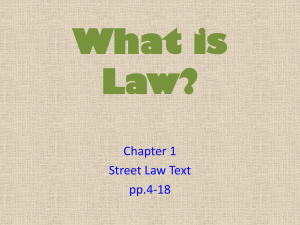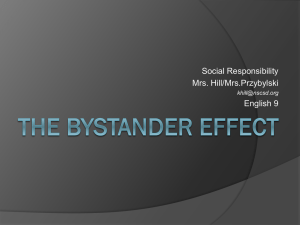Chapter 17 two-way anova
advertisement
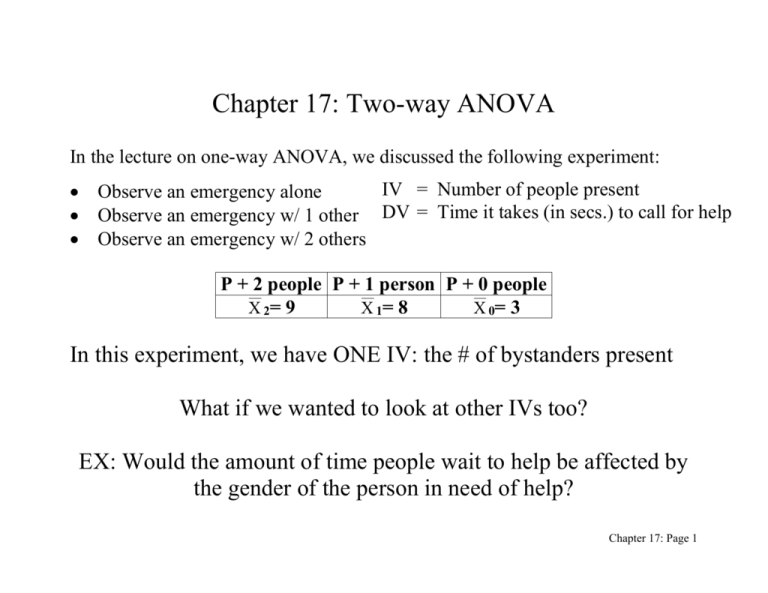
Chapter 17: Two-way ANOVA In the lecture on one-way ANOVA, we discussed the following experiment: IV = Number of people present Observe an emergency alone Observe an emergency w/ 1 other DV = Time it takes (in secs.) to call for help Observe an emergency w/ 2 others P + 2 people P + 1 person P + 0 people X 2= 9 X 1= 8 X 0= 3 In this experiment, we have ONE IV: the # of bystanders present What if we wanted to look at other IVs too? EX: Would the amount of time people wait to help be affected by the gender of the person in need of help? Chapter 17: Page 1 Let’s do an experiment where we stage an emergency situation: IV1: The victim of the emergency is either male OR female IV2: The P witnesses the emergency alone, w/ 1 other, OR 2 others These two IVs are “crossed,” meaning that each level of one IV is paired with all levels of the other IV Put another way, we have all possible combinations of the IVs P + 2 people P + 1 person P + 0 people Male victim X= 9 X= 8 X= 3 Female victim X= 4 X= 4 X= 2 Chapter 17: Page 2 VOCABULARY Factor = Independent variable Two-factor ANOVA / Two-way ANOVA: an experiment with 2 independent variables Levels: number of treatment conditions (groups) for a specific IV NOTATION 3 X 2 factorial = experiment w/ 2 IVs: one w/ 3 levels, one w/ 2 levels 2 X 2 factorial = experiment w/ 2 IVs: both w/ 2 levels 3 X 2 X 2 = ???? Chapter 17: Page 3 Why do a two-factor (two-way) ANOVA? 1. Greater generalizability of results --EX: If experiment is only done with a male victim, we don’t know if the results are also true for female victims 2. Allows one to look for interactions --The effect of one IV depends on the level of the other IV --EX: Sample of patients who have an infection: ¼ get antibiotics and are not allergic ¼ don’t get antibiotics and are not allergic ¼ get antibiotics and are allergic ¼ don’t get antibiotics and are allergic --Measure how well the patients feel the next day Chapter 17: Page 4 6 5 How do you feel right now? 5 4 Allergic? 3 3 No 3 Yes 2 1 1 0 No Yes Receive Anti-biotic This illustrates an interaction Chapter 17: Page 5 6 5 5 How do you feel right now? 5 4 Allergic? 3 3 No 3 Yes 2 1 0 No Yes Receive anti-biotic If there were no interaction, then the graph would have looked like this Chapter 17: Page 6 Let’s return to our bystander intervention experiment: P + 2 people P + 1 person P + 0 people Male victim X= 9 X= 8 X= 3 Female victim X= 4 X= 4 X= 2 When we do a two-way ANOVA, we will obtain three different statistical tests: 1. Main effect of IV1: Gender of Victim 2. Main effect of IV2: # of Bystanders Present 3. Interaction b/n the two IVs (gender & # of bystanders) Chapter 17: Page 7 Each is a hypothesis test: Gender Main Effect: H0: all levels of gender have the same mean H1: all levels of gender do not have the same mean Bystander Main Effect: H0: all levels of bystander have the same mean H1: all levels of bystander do not have the same mean Interaction: H0: there is no interaction between the factors H1: there is an interaction between the factors Chapter 17: Page 8 Main Effects Defined: The effect of ONE IV on the DV averaged across the levels of the other IV In our example: --Main effect of gender: Is there a difference in response time for male versus female victims, averaging over the number of bystanders present? That is: Ignoring the number of bystanders, does response time differ for male versus female victims? --Main effect of # of bystanders: Is there a difference in response time when there is 1 versus 2 versus 3 bystanders present, averaging over the victim’s gender? That is: Ignoring the gender of the victim, does response time differ based on the number of bystanders present? Chapter 17: Page 9 One way to understand main effects is to examine something called marginal means P + 2 people P + 1 person P + 0 people Male victim X= 9 Female victim X= 4 X = 6.5 Marginal Means Response time for 3 bystanders, averaging over gender (9 + 4) / 2 = 6.5 X= 8 X= 4 X =6 X= 3 X= 2 X Response time for 2 bystanders, averaging over gender (8 + 4) / 2 = 6 Marginal Means X X Response time for male victims, averaging over # of bystanders (9 + 8 + 3) / 3 = 6.67 = 6.67 = 3.33 = 2.5 Response time for 1 bystander, averaging over gender (3 + 2) / 2 = 2.5 Response time for female victims, averaging over # of bystanders (4 + 4 + 2) / 3 = 3.33 Chapter 17: Page 10 A main effect of gender asks: Do the marginal means of 6.67 (male victims) and 3.33 (female victims) differ? A main effect of # of bystanders asks: Do the marginal means of 6.5 (3 bystanders), 6 (2 bystanders), & 2.5 (1 bystander) differ? Chapter 17: Page 11 Calculations To perform all the calculations for Sums of Squares for a two-way anova by hand is time and labor intensive These are almost exclusively done using the aid of a statistical package, like SPSS Thus, I’ll just explain the calculations conceptually Chapter 17: Page 12 Calculations: Main Effects Sums of Squares Calculations for main effects SS in a two-way ANOVA are very similar to the calculations we used in one-way ANOVA Conceptually, to calculate the SS for a main effect, one is comparing each marginal mean to the overall (grand) mean P + 2 people P + 1 person P + 0 people Male victim X= 9 Female victim X= 4 X = 6.5 Marginal Means X= 8 X= 4 X =6 X= 3 X= 2 X = 2.5 Marginal Means X X = 6.67 = 3.33 Overall: 5 For a main effect of # of bystanders, one is taking the squared difference b/n: The mean from 3 bystanders & the overall mean (6.5 – 5) The mean from 2 bystanders & the overall mean (6-5) The mean from 1 bystander & the overall mean (2.5 – 5) These squared differences are multiplied by the # of scores per mean Chapter 17: Page 13 For a main effect of gender, one is taking the squared difference b/n: The mean from male victims & the overall mean (6.67 – 5) The mean from female victims & the overall mean (3.33-5) These squared differences are multiplied by the # of scores per mean Calculations: Sums of Squares Total The Total SS is calculated by summing the squared deviations between each score and the overall grand mean Chapter 17: Page 14 Calculations: Sums of Squares Cells The SS Cells is calculated by summing the squared deviations between each cell mean and the overall grand mean Each deviation is weighted by the number of observations in that cell Why would we want this? Cell means could differ b/c: 1. They come from different levels of gender 2. They come from different levels of # of bystanders 3. There is an interaction b/n gender & # of bystanders Chapter 17: Page 15 SS cells is made up of 3 parts: SS gender SS # of bystanders SS interaction We can calculate SS gender & SS # of bystanders directly Then, to find SS interaction: SS interaction = SS cells – SS gender – SS # of bystanders Chapter 17: Page 16 Calculations: Sums of Squares Error The SS error is “what’s left over” Of the total SS, we know what is due to gender (SS gender), what is due to the # of bystanders (SS bystanders) and what is due to the interaction (SS interaction). Thus: SSerror = SStotal – (SSgender + SSbystanders + SSinteraction) Chapter 17: Page 17 ANOVA Table Source df SS MS F Gender # of Bystanders Interaction (G*B) Error Total Chapter 17: Page 18 Calculations: Degrees of Freedom N–1 dftotal = (where N is the total sample size of the entire experiment) dfgender = k – 1 (where k is the # of gender levels) dfbystanders = k – 1 (where k is the # of bystander levels) dfinteraction = dfgender * dfbystanders (Product of the df for the two IVs) dferror = dftotal - dfgender - dfbystanders - dfinteraction Chapter 17: Page 19 Calculations: Mean Squares To find any MS, take the SS & divide by its corresponding df MSGender = SS Gender df Gender SS Bys tan ders MSBystanders = df Bys tan ders MSInteraction = SS Interaction df Interaction = SS Error df Error MSError Chapter 17: Page 20 Calculations: F statistics To find the 3 F statistics for our tests, take the MS for the 2 IVs & the MS for the interaction & divide them by the MSError FGender = MS Gender MS Error MS Bys tan ders FBystanders FInteraction = MS Error = MS Interaction MS Error Chapter 17: Page 21 Calculations: Critical Values To determine if a particular F statistic is statistically significant, you obtain the appropriate critical value from Table E.3 or E.4 For each F, you have two df: one for the corresponding factor and the dfError As usual, if the obtained F value equals or exceeds the critical value, then we reject the null hypothesis and conclude that we have a statistically significant effect Chapter 17: Page 22 Be twe en-S ubj ects Factors Interpreting SPSS Output N Gender of Vic tim # of by standers present f m 1.00 2.00 3.00 15 15 10 10 Main effect of gender 10 Tests of Between-Subjects Effects Dependent Variable: How long do P wait to help? Source Corrected Model Intercept GENDER BYSTAND GENDER * BYSTAND Error Total Corrected Total Type III Sum of Squares 200.000a 750.000 83.333 95.000 21.667 54.000 1004.000 254.000 df 5 1 1 2 2 24 30 29 a. R Squared = .787 (Adjus ted R Squared = .743) Mean Square 40.000 750.000 83.333 47.500 10.833 2.250 F 17.778 333.333 37.037 21.111 4.815 Sig. .000 .000 .000 .000 .017 Main effect of bystanders Interaction between gender & bystanders Chapter 17: Page 23 Estimated Marginal Means There was a main effect of gender, so these means differ 1. Gender of Victim Dependent Variable: How long do P wait to help? Gender of Victim f m Mean 3.333 6.667 Std. Error .387 .387 95% Confidence Interval Lower Bound Upper Bound 2.534 4.133 5.867 7.466 2. # of bystanders pre sent Dependent Variable: How long do P wait to help? # of by standers present 1.00 2.00 3.00 Mean 2.500 6.000 6.500 St d. Error .474 .474 .474 There was a main effect of bystander, so there is a difference among these means 95% Confidenc e Interval Lower Bound Upper Bound 1.521 3.479 5.021 6.979 5.521 7.479 Chapter 17: Page 24 3. Gender of Victim * # of bystanders present Dependent Variable: How long do P wait to help? Gender of Victim f m # of bys tanders pres ent 1.00 2.00 3.00 1.00 2.00 3.00 Mean 2.000 4.000 4.000 3.000 8.000 9.000 Std. Error .671 .671 .671 .671 .671 .671 95% Confidence Interval Lower Bound Upper Bound .615 3.385 2.615 5.385 2.615 5.385 1.615 4.385 6.615 9.385 7.615 10.385 There was a significant interaction, so the effect of bystander depends on the level of gender Chapter 17: Page 25 Multiple-comparison procedures: Post-hoc tests VS simple effects Understanding Main Effects If there is a significant main effect, & that factor has only two levels, you know that those two marginal means differ significantly from each other If there is a significant main effect, & that factor has 3 or more levels, you know that at least two of those marginal means differ. Need multiplecomparison procedures (post-hocs) to determine which ones. Can be obtained in SPSS Chapter 17: Page 26 Post Hoc Tests: # of bystanders present Multiple Com pari sons Dependent Variable: How long do P wait to help? LS D (I) # of bys tanders present 1.00 2.00 3.00 (J) # of bys tanders present 2.00 3.00 1.00 3.00 1.00 2.00 Mean Difference (I-J) St d. E rror -3. 5000* .6708 -4. 0000* .6708 3.5000* .6708 -.5000 .6708 4.0000* .6708 .5000 .6708 Based on observed means. *. The mean differenc e is significant at the .05 level. Sig. .000 .000 .000 .463 .000 .463 95% Confidenc e Interval Lower Bound Upper Bound -4. 8845 -2. 1155 -5. 3845 -2. 6155 2.1155 4.8845 -1. 8845 .8845 2.6155 5.3845 -.8845 1.8845 1 bystander differs from 2 1 bystander differs from 3 2 bystanders DO NOT differ from 3 Chapter 17: Page 27 Multiple-comparison procedures: Post-hoc tests VS simple effects Understanding Interactions An interaction occurs when the effect of one IV depends on the level of the other IV If you obtain a significant interaction, you may want to examine it closely to see what is causing it A useful first step is to graph the means to see the pattern of the interaction Can be obtained in SPSS or done “by hand” Chapter 17: Page 28 You could graph the means two different ways: Estimated Marginal Means of How long do P wait to help? 10 Estimated Marginal Means 8 6 4 # of bys tanders pres 1.00 2 2.00 0 3.00 f m Gender of Victim Graphed this way, we see that the bystander effect seems smaller for female victims compared to male victims Chapter 17: Page 29 Estimated Marginal Means of How long do P wait to help? 10 Estimated Marginal Means 8 6 4 Gender of Victim 2 f 0 1.00 m 2.00 3.00 # of bys tanders present Graphed this way, we see that male and female victims get helped about equally quickly with one bystander present, but when multiple bystanders are present, a gender difference emerges Chapter 17: Page 30 Understanding Interactions Another thing to do to understand an interaction is to calculate “simple effects” “The effect of one IV at one level of another IV” Can be done in SPSS using Syntax Chapter 17: Page 31 Simple effects of gender at each level of bystander: There is no difference in response time for male and female victims when only 1 bystander is present Univariate Tests Dependent Variable: How long do P wait to help? # of bys tanders pres ent 1.00 2.00 3.00 Contrast Error Contrast Error Contrast Error Sum of Squares 2.500 54.000 40.000 54.000 62.500 54.000 df 1 24 1 24 1 24 Mean Square 2.500 2.250 40.000 2.250 62.500 2.250 F 1.111 Sig. .302 17.778 .000 27.778 .000 Each F tests the simple effects of Gender of Victim within each level combination of the other effects shown. These tests are based on the linearly independent pairwise comparisons among the estimated marginal means. There is a difference between male and female victims in response time when 2 or 3 bystanders are present Chapter 17: Page 32 Simple effects of bystander at each level of gender: Univa riate Te sts Dependent Variable: How long do P wait to help? Gender of Victim f Contrast Error m Contrast Error Sum of Squares 13.333 54.000 103.333 54.000 df 2 24 2 24 Mean Square 6.667 2.250 51.667 2.250 F 2.963 Sig. .071 22.963 .000 Each F tes ts the s imple effects of # of bystanders present within eac h level c ombinat ion of the other effec ts shown. These test s are based on t he linearly independent pairwise c omparis ons among the estimat ed marginal means. There is a difference among the levels of bystander for male victims. There is no such difference for female victims Chapter 17: Page 33 Interpretation Reporting the results of a two-way anova is complex because there are so many tests conducted. Below is one way you might report the results of the above analyses: “An experiment was conducted to determine if the number of bystanders present in an emergency situation and the gender of the victim in an emergency situation affect the time it takes a person to help. A two-way ANOVA found a main effect of gender, F(1,24)=37.037, p ≤ .05, indicating that female victims are helped sooner than male victims. There was also a main effect of the number of bystanders present, F(2,24)=21.111, p ≤ .05. This effect showed that a lone bystander helped much sooner than when there were 2 or 3 bystanders present. Finally, there was an interaction between gender and the number of bystanders present, F(2,24)=4.815, p ≤ .05. Simple effects tests showed that male and female victims receive help equally quickly when only 1 bystander is present, F(1,24)=1.11, p > .05. However, when 2 or 3 bystanders are present, female victims were helped more quickly than male victims, F(1,24)=17.778, p ≤ .05 for 2 bystanders and F(1,24)=27.778, p ≤ .05 for 3 bystanders.” Chapter 17: Page 34 Filling in an ANOVA Table You should be able to complete a partially filled in ANOVA table Let’s suppose we did an experiment where we investigate the effectiveness of advertisements. We manipulate: IV1: Whether the ad has a celebrity spokesperson or a “normal” person IV2: Whether the ad is in black/white or color DV: How persuasive do Ps find the ad on a scale where 1 = Not at all persuaded; 7 = Extremely persuaded There are 20 participants “per cell” Chapter 17: Page 35 ANOVA Table Source df SS Spokesperson Color 200 150 Interaction (S*C) Error Total 50 MS F 850 We should be able to complete everything else! Calculate df Spokesperson has 2 levels df = (k – 1) = (2 – 1) = 1 Color has 2 levels df = (k – 1) = (2 – 1) = 1 Interaction df is the product of the df for the 2 IVs = 1*1 = 1 Total df = (N – 1) = (80-1) = 79 Error df = “what’s left over” (79 – 1 – 1 – 1) = 76 Chapter 17: Page 36 Source df SS Spokesperson Color 1 1 200 150 Interaction (S*C) Error Total 1 76 79 50 MS F 850 The SS for all factors and interactions should add up to the total SS. Thus: SSerror = SStotal – SSspokesperson – SScolor - SSinteraction SSerror = 850 – 200 – 150 – 50 = 450 Chapter 17: Page 37 Source df SS Spokesperson Color 1 1 200 150 Interaction (S*C) Error Total 1 76 79 50 450 850 SS spokesperson MSSpokesperson = df spokesperson MSInteraction = 200 200 1 SS Interaction 50 50 df Interaction 1 MS MScolor = MSError = F SScolor 150 150 df color 1 SS Error 450 5.92 df Error 76 Chapter 17: Page 38 Source df SS MS Spokesperson Color 1 1 200 150 200 150 Interaction (S*C) Error Total 1 76 79 50 450 850 50 5.92 MS Spokesperson FSpokesperson = FInteraction = MS Error 200 33.78 5.92 FColor = F MS Color 150 25.34 MS Error 5.92 MS Interaction 50 8.45 MS Error 5.92 Chapter 17: Page 39 Source df SS MS F Spokesperson Color 1 1 200 150 200 150 33.78 25.34 Interaction (S*C) Error Total 1 76 79 50 450 850 50 5.92 8.45 Finally, we’d compare each F to the appropriate critical F value All tests in this example have 1,76 df. Assuming = .05, from Table E.3, we’ll use the df that are closest to but smaller than the actual df, b/c they are not listed Thus, we will use the df for (1,60) = 4.00 All F’s exceed the critical value Chapter 17: Page 40

